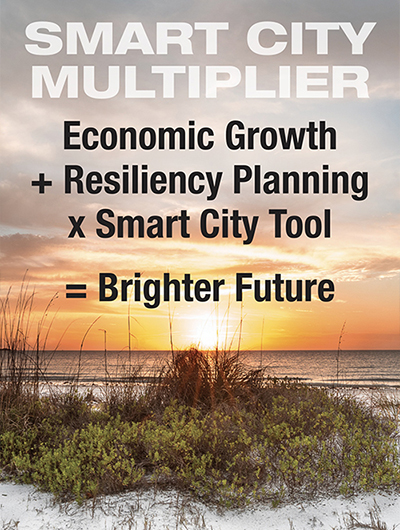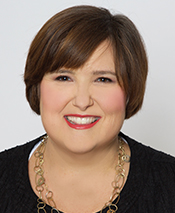Smart Cities — Creating a Brighter Future
By Alison Barlow
A smart city is one that improves the quality of life for its residents by using technology to respond to challenges being faced in an ever-changing environment. With that said, there is no one definition for being a smart city and there is no moment (at least for me) that a city is finally smart. It is a gradual process that begins with small steps such as citizen feedback tools where potholes and safety issues are reported or smart parking applications that eliminate coins and track available spots. It grows to include infrastructure improvements of new streetlights or motion sensor pedestrian crosswalks. Most residents may never acknowledge, or even realize, that they are living in a smart city. Rather they will simply know they live in a community that is adaptive, responsive and delivers on the promise that is a great place to live, work and play.
A smart city strategy for some municipalities may describe a vision that resembles Orbit City from the Jetsons, while others keep technology in the background. No matter the approach, smart cities technology is a tool for economic development, for resiliency and for future planning.
Fondly known as “The Sunshine City,” St. Petersburg, Florida, is in the midst of an incredible renaissance. Once known for retirees, St. Petersburg now boasts one of the state’s youngest median ages, a world-renown arts sector and a technology start-up community that is growing by leaps and bounds. People recognize St. Petersburg as a vibrant, evolving, mid-sized city in one of the most dynamic regions in the country, Tampa Bay — largely thanks to our dedication to being a smarter city.
Our smart city journey accelerated last year through a partnership with US Ignite and Charter Communications. The first meeting was less about technology, and more about the challenges our community needs to address. They ranged from the impacts of being a coastal community in the midst of climate change with severe weather and rising oceans, to public safety needs in an increasingly cosmopolitan and populated urban center. They also included the challenges of growing and diversifying our business community moving beyond a traditional tourism based economy to one that embraces entrepreneurship, financial services, research and technology. This conversation was critical to pivot the discussion from the latest technology tool to an approach for impactful change. It set the foundation that could weather inevitable implementation challenges.
The community needs, though commonly understood, were substantiated in existing initiatives such as an equitable economic development strategy (Grow Smarter), an environmental sustainability plan (Integrated Sustainability Action Plan) and a multimodal transportation plan (Complete Streets). Efforts such as these exist in many cities and should not be overlooked. Leveraging these also facilitated the engagement of diverse leaders from industry partners, public and private sector along with the nonprofit community. They had participated in the development of one or more of the plans and quickly understood the value in collaboration. This is critical to encourage all to come to the table for a robust smart city approach.
Numerous reports exist about the potential risks from introducing technology into a community. Residents are concerned about impacts of data analysis tools that might magnify implicit bias, a lack of data privacy, and the unknown implications to their personal health. They are right to be cautious. Pilot projects provide an opportunity to demonstrate what is possible with technology; to adjust the technology to address concerns; and to validate the value of these tools to solve the residents’ unique problems.
Our group selected two pilot projects. The first pilot project, Guardians of the Gulf, seeks to inform our youth about what it means to face risks associated with escalating coastal threats such as sunny day flooding, strengthening storms, and microplastics in Tampa Bay. It links the expertise of our marine science and ocean health experts at the University of South Florida College of Marine Science with children in the Boys and Girls Clubs of the Suncoast. The students experience web-based activities including viewing underwater cameras tracking the progress of an artificial reef, video from underwater drones, and live interactions with scientists in labs and the field. Though not a typical smart city project, this was relevant to our community and is enthusiastically supported. Innovative projects such as these should be pursued because they engage non-typical partners, unleash creativity, and break down intimidating technology barriers.
The second pilot project is a smart lighting project on the campus of the University of South Florida St. Petersburg. Lighting poles are the foundation on which sensors and technology applications are tested. This project helps to answer what smart infrastructure makes sense for our community. Questions considered include: Do the cost savings and new insights result in value for us? Should this be integrated in new development? What challenges result when retrofitting into existing spaces?
 But plans and pilot projects are only the beginning. The agility of a smart city to adapt to the unforeseen is critical. This article was written amidst COVID-19 safer at home restrictions, closed schools and a growing telecommuting workforce. Suddenly the broadband access and smart city technology is not just an interesting conversation about the future city but fundamentally essential for our daily lives. Schools, businesses, and even social gatherings are all digital during this pandemic. People without access to technology can be left even further behind. COVID-19 is taking the goal of digital inclusion from aspirational and hypothetical to necessity.
But plans and pilot projects are only the beginning. The agility of a smart city to adapt to the unforeseen is critical. This article was written amidst COVID-19 safer at home restrictions, closed schools and a growing telecommuting workforce. Suddenly the broadband access and smart city technology is not just an interesting conversation about the future city but fundamentally essential for our daily lives. Schools, businesses, and even social gatherings are all digital during this pandemic. People without access to technology can be left even further behind. COVID-19 is taking the goal of digital inclusion from aspirational and hypothetical to necessity.
For our community, a discussion that started in December as part of the next wave of smart city related activities, suddenly became the most important priority. The experience of residents has illustrated the inequity that exists in our digital economy. It became the responsibility of the whole community — industry partners, public and private sector, nonprofit community — to care for each other and prioritize 100% digital inclusion.
A digitally inclusive city is one where all individuals, including the most disadvantaged, have access to online resources, as well as the skills to use them meaningfully. This is necessary for lifelong learning, employment, civic participation, and the ability to reach essential services. Though many individuals possess smart cellular phones, that is not enough to fully participate. Individuals and households across the city, particularly in areas adjacent to high growth in both residential luxury housing stock and relocating commercial enterprises, must have access to skills to improve their economic situation. We, like many around the country, responded to these needs by expanding Internet access, distributing laptops and tablets, and providing technical assistance. These are stop-gap measures to address the immediate need. However, it is imperative that a sustainable plan for digital inclusion should be in every smart city strategy.
Innovation flourishes in smart cities. A successful smart city strategy is not a one size fits all solution, but rather a constellation of tools and ingenuity adapted for the unique challenges of that community. Being a smart city is most valuable when technology is used to accelerate the development of a city and create a brighter future for its residents. In today’s world being a smart city means being a successful city.

Alison Barlow,
Executive Director,
St. Petersburg
Innovation District
Alison Barlow is the Executive Director of the St. Petersburg Innovation District, a public-private partnership that is expanding economic activity in healthcare, marine science, technology and research. She also leads St. Petersburg’s smart city efforts. Ms. Barlow received a BS from Florida State University, and a MBA from American University. Prior to joining the District, she led technology projects in Washington DC and developed strategic plans for organizations across the Tampa Bay region.
Shutterstock




